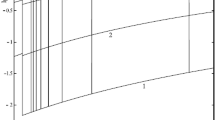Abstract
Two small radio flares following the great gamma-ray burst on 11 June 1991 are studied. We analyse the different association of emission features at microwaves, decimeter waves, and soft and hard X-rays for the events. The first flare has well-defined emission features in microwaves and soft and hard X-rays, and a faint decimetric signature well after the hard X-ray burst. It is not certain if the decimetric event is connected to the burst features. The second event is characterized by an almost simultaneous appearance of hard X-ray burst maxima and decimetric narrowband drift bursts, but soft X-ray emission is missing from the event. With the exception of the possibility that the soft X-ray emission is absorbed along the way, the following models can explain the reported differences in the second event: (1) Microwave emission in the second event is produced by ≤150 keV electrons spiraling in the magnetic field relatively low in the corona, while the hard X-ray emission is produced at the beginning of the burst near the loop top as thick-target emission. If the bulk of electrons entered the loop, the low-energy electrons would not be effectively mirrored and would eventually hit the footpoints and cause soft X-ray emission by evaporation, which was not observed. The collisions at the loop top would not produce observable plasma heating. The observed decimetric type III bursts could be created by plasma oscillations caused by electron beams traveling along the magnetic field lines at low coronal heights. (2) Microwave emission is caused by electrons with MeV energies trapped in the large magnetic loops, and the electrons are effectively mirrored from the loop footpoints. The hard X-ray emission can come both from the loop top and the loop footpoints as the accelerated lower energy electrons are not mirrored. The low-energy electrons are not, however, sufficient to create observable soft X-ray emission. The type III emission in this case could be formed either at low coronal heights or in local thick regions in the large loops, high in the corona.
Similar content being viewed by others
References
Aschwanden, M. J.: 1987, Solar Phys. 111, 113.
Aschwanden, M. J., Benz, A. O., Dennis, B. R., and Schwartz, R. A.: 1995, Astrophys. J. 455, 347.
Benz, A. O., Bernold, T. E. X., and Dennis, B. R.: 1983, Astrophys. J. 271, 355.
Benz, A. O., Barrow, C. H., Dennis, B. R., Pick, M., Raoult, A., and Simnett, G.: 1983, Solar Phys. 83, 267.
Castelli, J. P., Guidice, D. A., Forrest, D. J., and Babcock, R. R.: 1974, J. Geophys. Res. 79, 889.
Cornell, M. E., Hurford, G. J., Kiplinger, A. L., and Dennis, B. R.: 1984, Astrophys. J. 279, 875.
Crannell, C. J., Frost, K. J., Matzler, C., Ohki, K., and Saba, J. L.: 1978, Astrophys. J. 223, 620.
Dulk, G. A.: 1985, Ann. Rev. Astron. Astrophys. 23, 169.
Dulk, G. A. and Marsh, K. A.: 1982, Astrophys. J. 259, 350.
Fishman, G. J., Meegan, C. A., Wilson, R. B., Brock, M. N., Horack, J. M., Kouveliotou, C., Howard, S., Paciesas, W. S., Briggs, M. S., Pendleton, G. N., Koshut, T. M., Mallozzi, R. S., Stollberg, M., and Lestrade, J. P.: 1994, Astrophys. J. Suppl. Ser. 92, 229.
Gaizauskas, V. and Tapping, K. F.: 1980, Astrophys. J. 241, 804.
Gotwols, B. L.: 1973, Solar Phys. 33, 475.
Hamilton, R. J., Petrosian, V., and Benz, A. O.: 1990, Astrophys. J. 358, 644.
Kanbach, G., Bertsch, D. L., Fichtel, C. E., Hartman, R. C., Hunter, S. D., Kniffen, D. A. et al.: 1993, Astron. Astrop. Suppl. Ser. 97, 349.
Kane, S. R.: 1981, Astrophys. J. 247, 1113.
Kane, S. R., Benz, A. O., and Treumann, R. A.: 1982, Astrophys. J. 263, 423.
Kaufmann, P., Strauss, F. M., Costa, J. E. R., Dennis, B. R., Kiplinger, A., Frost, K. J., and Orwig, L. E.: 1983, Solar Phys. 84, 311.
Kosugi, T., Dennis, B. R., and Kai, K.: 1988, Astrophys. J. 324, 1118.
Kundu, M. R., White, S. M., Gopalswamy, N., and Lim, J.: 1994, Astrophys. J. Suppl. Ser. 90, 599.
Lu, E. T. and Petrosian, V.: 1990, Astrophys. J. 354, 735.
Mann, G., Aurass, H., Paschke, J., and Voigt, W.: 1992, ESA-SP 348, 129.
Masuda, S.: 1994, Ph.D. Thesis, The Yohkoh HXT Group, National Astronomical Observatory, Tokyo, Japan.
Masuda, S., Kosugi, T., Hara, H., Tsuneta, S., and Ogawara, Y.: 1994, Nature 371, 495.
Pohjolainen, S., Urpo, S., and Herrmann, R.: 1996, Adv. Space Res. 17(4/5), 139.
Pohjolainen, S., Valtaoja, E., and Urpo, S.: 1996, Astron. Astrophys. 314, 947.
Raoult, A., Pick, M., Dennis, B. R., and Kane, S. R.: 1985, Astrophys. J. 299, 1027.
Raoult, A., Correia, E., Lantos, P., Kaufmann, P., Klein, K. L., and de Genouillac, G: 1989, Solar Phys. 120, 125.
Sawant, H. S., Lattari, C. J. B., Benz, A. O., and Dennis, B. R.: 1990, Solar Phys. 130, 57.
Stepanov, A. V., Urpo, S., and Zaitsev, V. V.: 1992, Solar Phys. 140, 139.
Thomas, R. J., Starr, R., and Crannell, C. J.: 1985, Solar Phys. 95, 323.
Trottet, G.: 1986, Solar Phys. 104, 145.
Trottet, G., Pick, M., and Heyvaerts, J.: 1979, Astron. Astrophys. 79, 164.
Trottet, G., Vilmer, N., Barat, C., Dezalay, J. P., Talon, R., Sunyaev, R., Kuznetsov, A., and Terekhov, O.: 1993, Astron. Astrophys. Suppl. Ser. 97, 337.
Urpo, S., Pohjolainen, S., and Teräsranta, H.: 1994, Metsähovi Radio Research Station Rep. Ser. A, No. 16, 1.
Vilmer, N.: 1987, Solar Phys. 111, 207.
Wheatland, M. S. and Melrose, D. B.: 1995, Solar Phys. 158, 283.
White, S. M., Kundu, M. R., Bastian, T. S., Gary, D. E., Hurford, G. J., Kucera, T., and Bieging, J. H.: 1992, Astrophys. J. 384, 656.
Wiehl, H. J., Benz, A. O., and Aschwanden, M. J.: 1985, Solar Phys. 95, 167.
Author information
Authors and Affiliations
Rights and permissions
About this article
Cite this article
Pohjolainen, S., Valtaoja, E., Urpo, S. et al. MICROWAVE EMISSION FROM CORONAL HEIGHTS: STUDY OF A NON-THERMAL RADIO FLARE. Solar Physics 173, 131–149 (1997). https://doi.org/10.1023/A:1004962007712
Issue Date:
DOI: https://doi.org/10.1023/A:1004962007712



